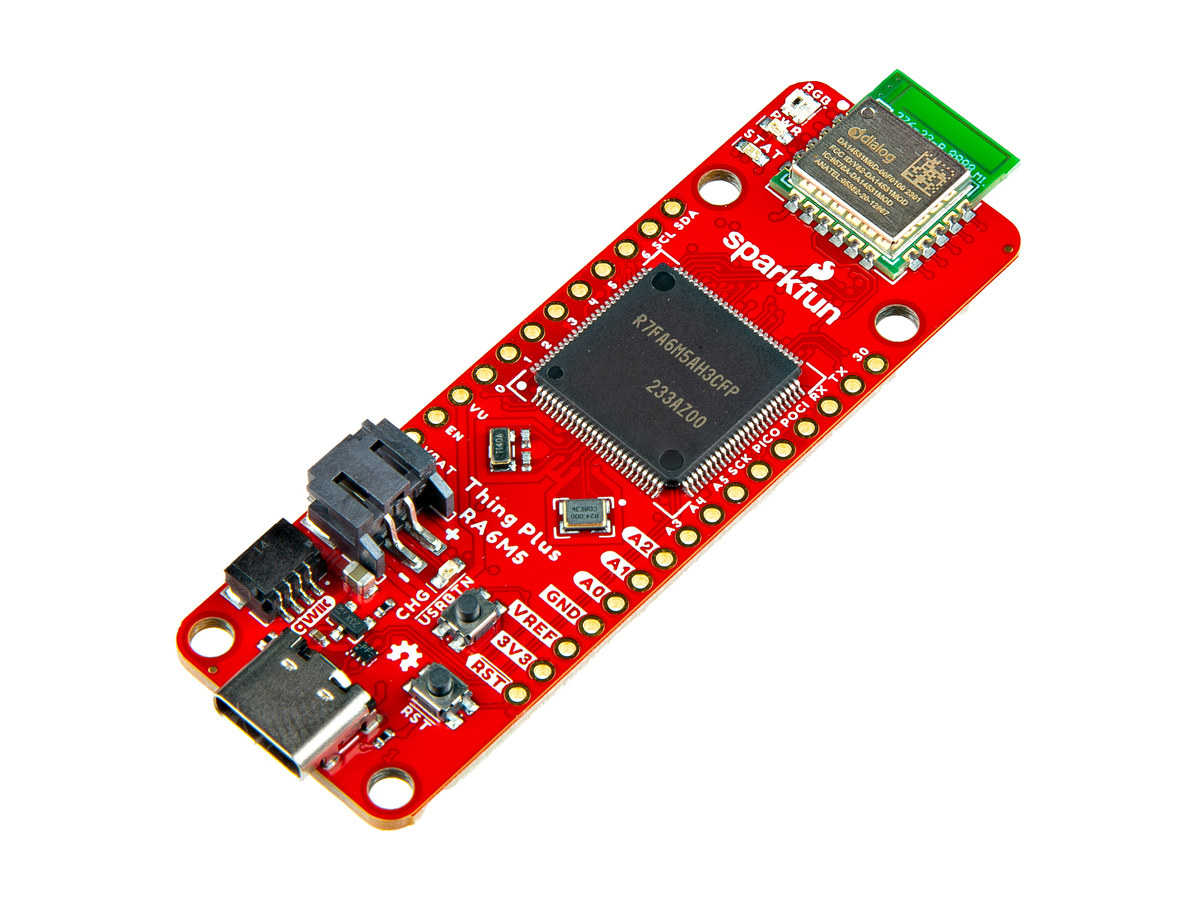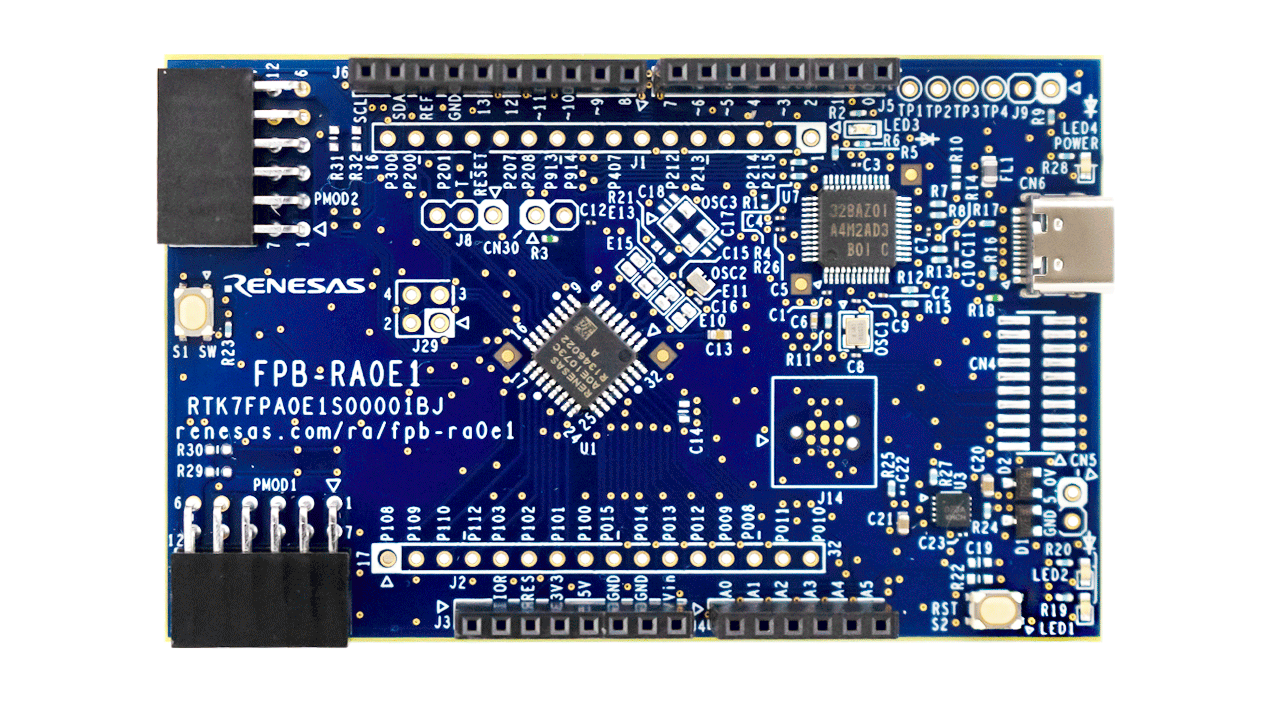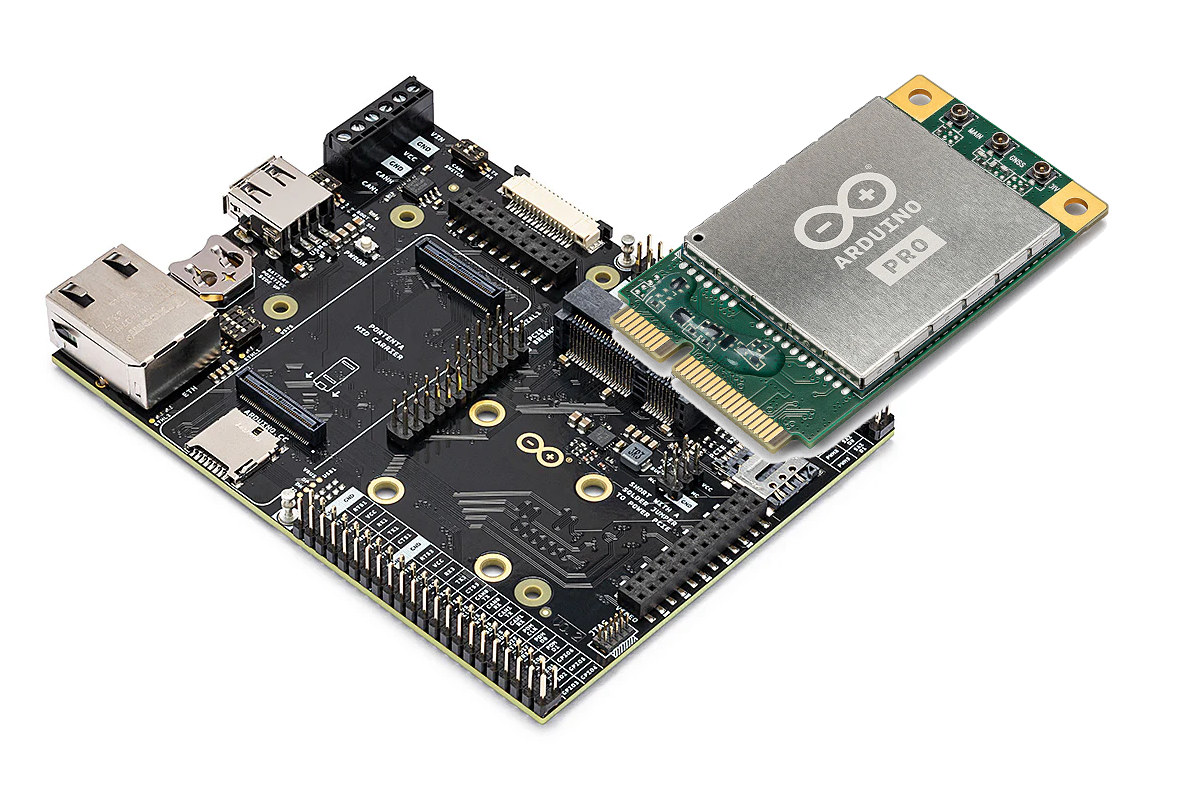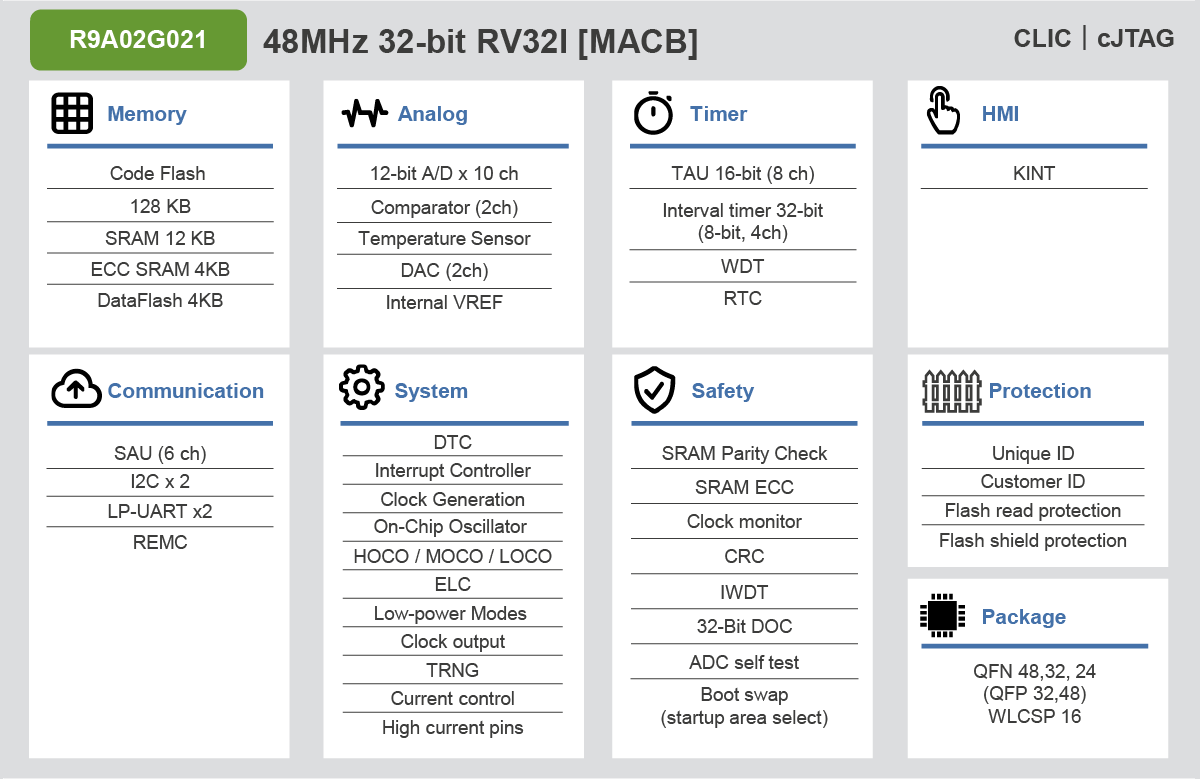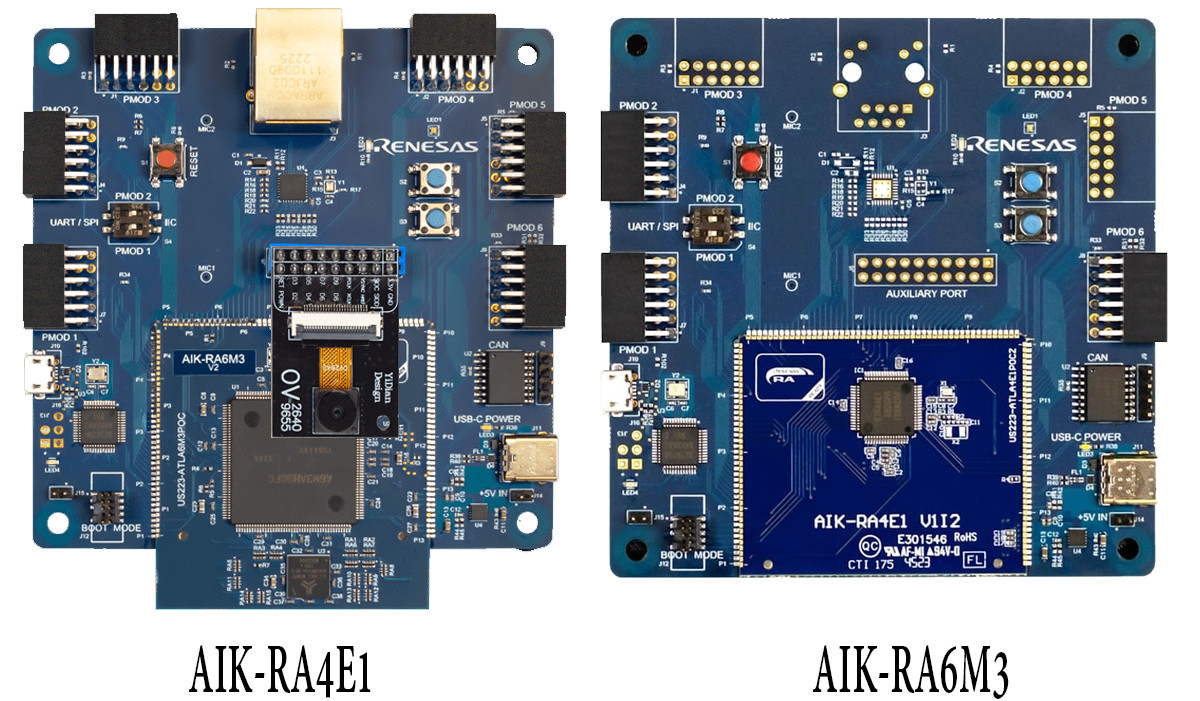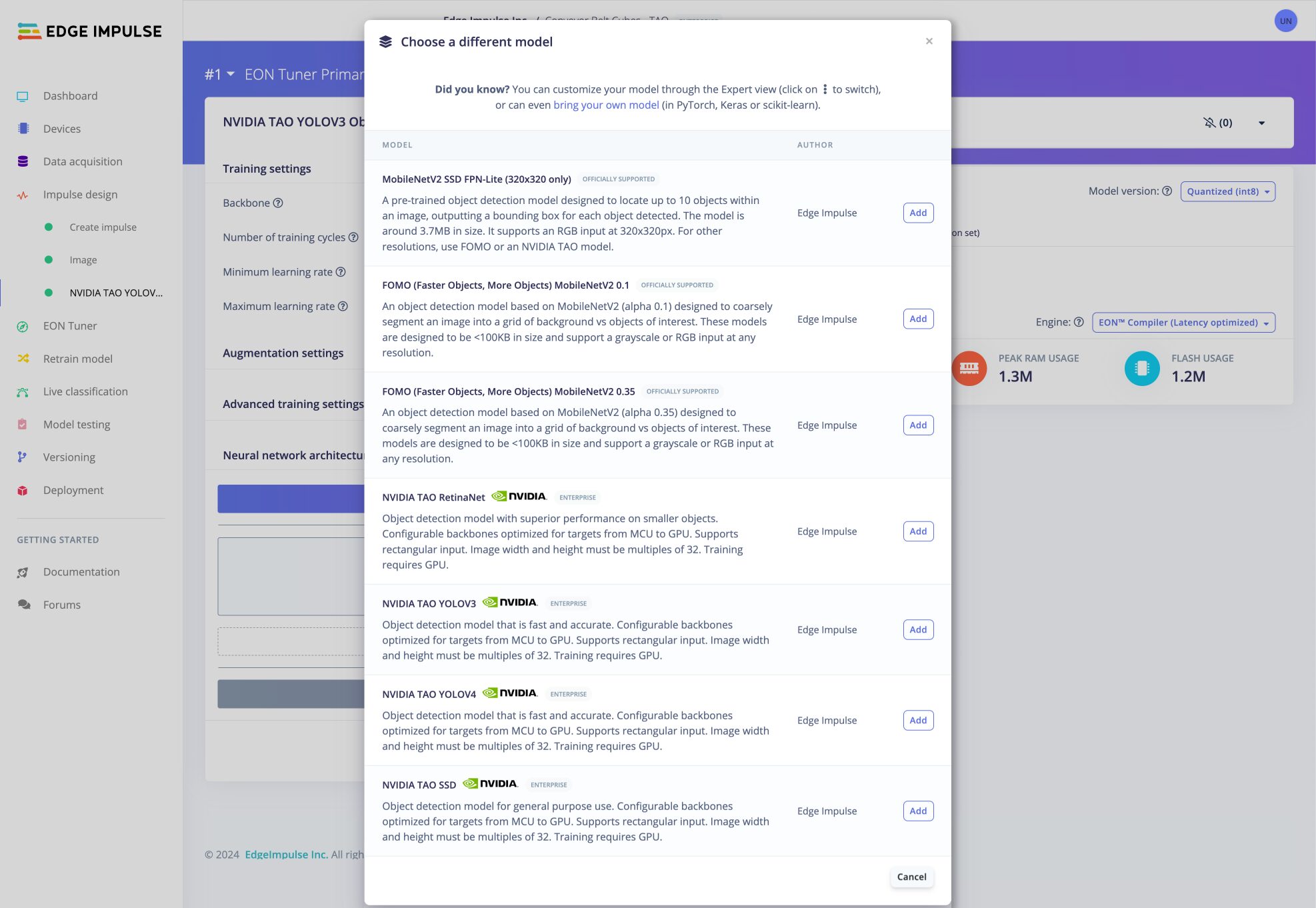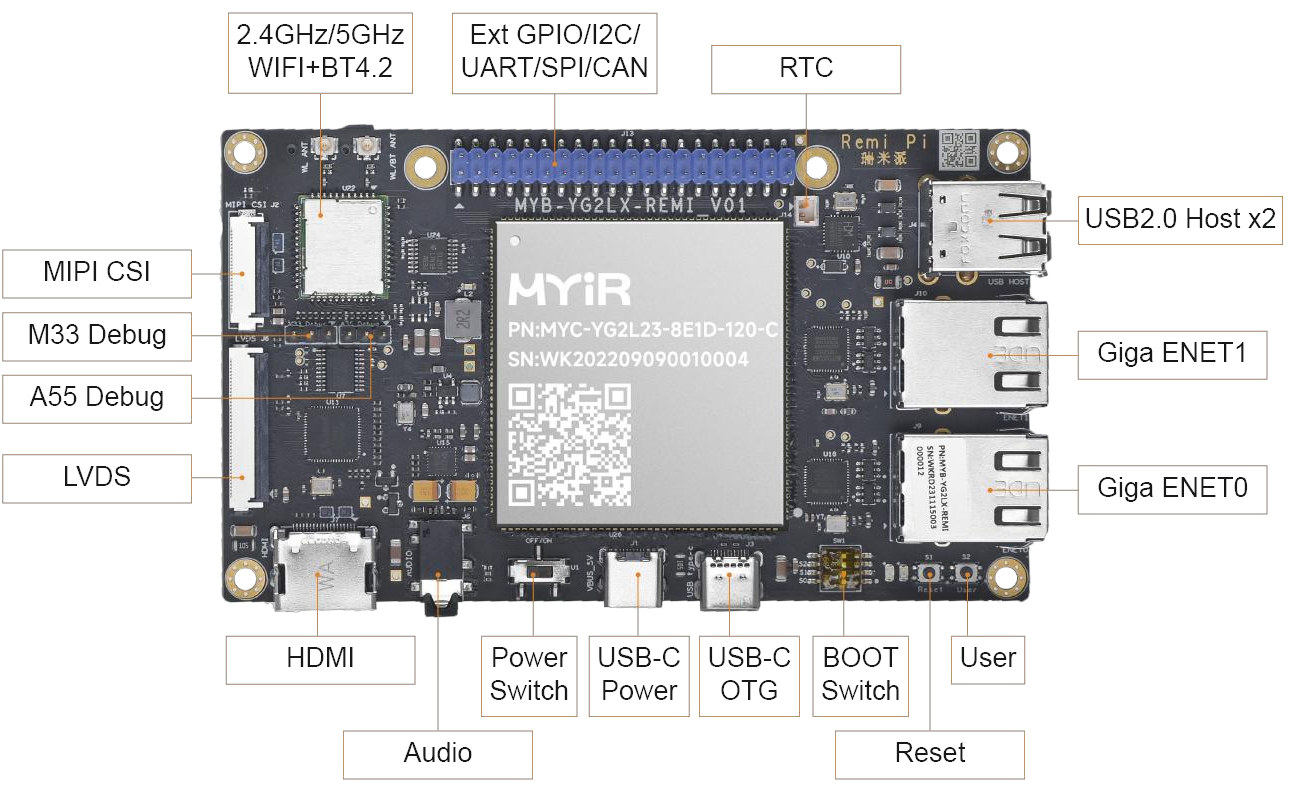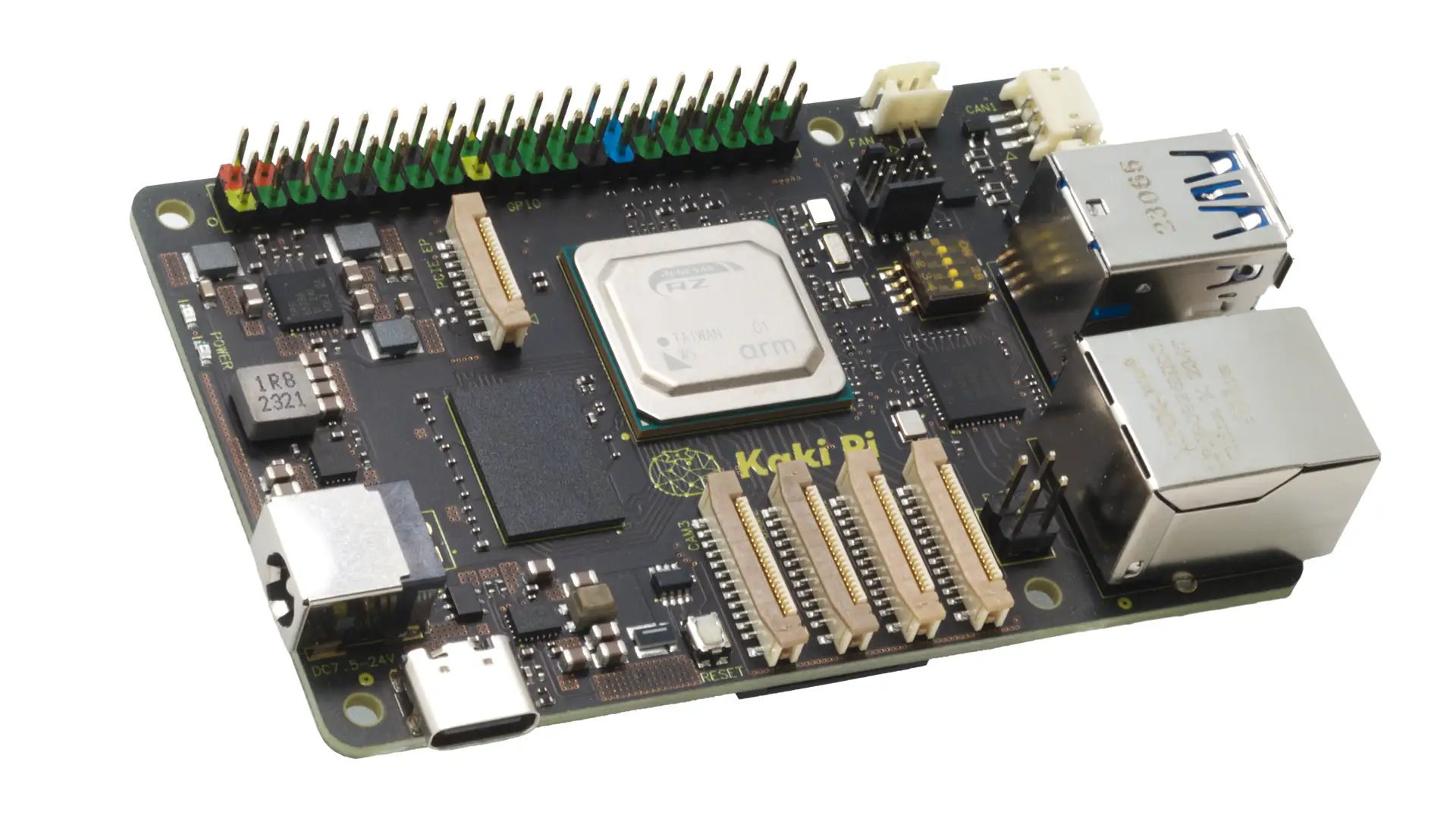SparkFun Thing Plus – RA6M5 is a small MCU board based on a 200 MHz Renesas RA6M5 Cortex-M33 microcontroller and a Renesas DA14531MOD Bluetooth 5.1 LE module that follows Adafruit Feather/Sparkfun Thing Plus form factor. The module can transmit data over BLE with just 4mA (at 3.3V) power consumption and the company claims the board to be powered by a coin-cell battery. A LiPo battery can also be connected to the board through a 2-pin JST battery connector, and the Things Plus – RA6M5 board also features a single-cell charger and LiPo fuel gauge. Sparkfun Thing Plus – RA6M5 specifications: Microcontroller – Renesas R7FA6M5AH3CFP Core – Arm Cortex-M33 microcontroller @ up to 200 MHz Memory – 512KB SRAM Storage – 2MB Flash Security – Arm TrustZone, and Secure Crypto Engine 9 Wireless – Renesas DA14531MOD module for Bluetooth 5.1 LE connectivity with support for CodeLess AT command Datapump Radio Transmit […]
Renesas RA0 Cortex-M23 MCU series target power and cost-sensitive applications
Renesas has announced the new low-power RA0 microcontroller series based on the power-efficient Arm Cortex-M23 core and the entry-level RA0E1 Group in the series. According to Renesas, the RA0 microcontrollers offer the “industry’s lowest overall power consumption for general-purpose 32-bit MCUs.” With a current consumption of 84.3 μA/MHz in active mode and only 0.82 mA in sleep mode, these microcontrollers are built to provide ultra-low power consumption. They also offer a Software Standby mode where the CPU, peripheral functions, and internal oscillators cease to operate. This mode reduces power consumption further by 99% down to 0.20 µA. They also come with a high-precision, High-speed On-Chip Oscillator (HOCO) for fast wake-up. The Cortex-M23 core is based on the Armv8-M instruction set and offers a maximum clock frequency of 32 MHz, with up to 64KB of code flash memory and 12KB SRAM for storing application code and data. This feature set makes […]
Arduino announces the Pro 4G Module and Portenta Mid Carrier board at Embedded World 2024
Arduino has announced two new products that are part of the Arduino Pro family at Embedded World 2024: the Arduino Pro 4G Module and Arduino Portenta Mid Carrier board. Arduino Pro 4G module Two variants of the mini PCIe module are available: one global and one for the EMEA and Southeast Asia markets with similar interfaces, but based on different Quectel modules, and the global model also supports GNSS. Specifications: Both also support 3G/2G fallback if 4G LTE network connectivity is out of range. The 4G LTE module works with Arduino Pro carrier boards featuring a mini PCIe connector such as the Max Carrier and the new Mid Carrier which we will be covering below. More information can be found on the documentation website and product page. The Arduino Pro 4G module global goes for $65 while the EMEA version sells for 29 Euros. Those prices are without antennas which […]
R9A02G021 is the first microcontroller with Renesas 32-bit RISC-V CPU core design
Renesas R9A02G021 is the first MCU group to use the company’s in-house designed 32-bit RISC-V CPU core with 3.27 CoreMark/MHz, RV32I base plus M/A/C/B extensions, and features such as a stack monitor register, a dynamic branch prediction unit, and a JTAG debug interface. Renesas has been making RISC-V chips at least since 2022 with the likes of RZ/Five 64-bit microprocessor and R9A06G150 32-bit voice control ASSP. All those were based on Andes RISC-V cores, but since the company has now designed its own 32-bit core, future Renesas 32-bit RISC-V microcontrollers are all likely to feature the in-house core, starting with the R9A02G021 general-purpose MCU group. Renesas R9A02G021 key features and specifications: RISC-V Core Renesas RISC-V instruction-set architecture (RV32I + MACB + Ziscr, Control and Status Register (CSR) instructions + RISC-V Zifencei Instruction-Fetch Fence) Maximum operating frequency – 48 MHz Debug and Trace – RISC-V External Debug Support cJTAG Debug Port […]
Renesas AIK-RA4E1 and AIK-RA6M3 reference kits are designed for accelerated AI/ML development
Renesas AIK-RA4E1 and AIK-RA6M3 are two new development boards based on RA-series 32-bit microcontrollers. These new dev boards have multiple reconfigurable connectivity functions to accelerate AI and ML design and development time. Both boards appear similar, but the AIK-RA4E1 uses the R7FA4E110D2CFM MCU, features three Pmod ports, and has no Ethernet support. On the other hand, the AIK-RA6M3 utilizes the R7FA6M3AH3CFC MCU, has six Pmod ports, and includes Ethernet support. Both the boards support full-speed USB and CAN bus. Renesas AIK-RA4E1 and AIK-RA6M3 reference kits specifications (Consolidated): RA4E1 Microcontroller Features: Model: R7FA4E110D2CFM Package: 64-pin LQFP Core: 100 MHz Arm Cortex-M33 SRAM: 128 KB on-chip Code Flash Memory: 512 MB on-chip Data Flash Memory: 8 KB on-chip RA6M3 Microcontroller Features: Model: R7FA6M3AH3CFC Package: 176-pin LQFP Core: 120 MHz Arm Cortex-M4 with FPU SRAM: 640 KB on-chip Code Flash Memory: 2 MB on-chip Data Flash Memory: 64 KB on-chip Connectivity: One USB […]
Edge Impulse machine learning platform adds support for NVIDIA TAO Toolkit and Omniverse
Edge Impulse machine learning platform for edge devices has released a new suite of tools developed on NVIDIA TAO Toolkit and Omniverse that brings new AI models to entry-level hardware based on Arm Cortex-A processors, Arm Cortex-M microcontrollers, or Arm Ethos-U NPUs. By combining Edge Impulse and NVIDIA TAO Toolkit, engineers can create computer vision models that can be deployed to edge-optimized hardware such as NXP I.MX RT1170, Alif E3, STMicro STM32H747AI, and Renesas CK-RA8D1. The Edge Impulse platform allows users to provide their own custom data with GPU-trained NVIDIA TAO models such as YOLO and RetinaNet, and optimize them for deployment on edge devices with or without AI accelerators. NVIDIA and Edge Impulse claim this new solution enables the deployment of large-scale NVIDIA models to Arm-based devices, and right now the following object detection and image classification tasks are available: RetinaNet, YOLOv3, YOLOv4, SSD, and image classification. You can […]
Remi Pi is a compact, low-cost SBC powered by a Renesas RZ/G2L Cortex-A55/M33 SoC
MYiR Tech Remi Pi is a low-cost SBC based on the company’s MYC-YG2LX CPU module featuring a Renesas RZ/G2L Arm Cortex-A55/M33 processor, 1GB RAM, 8GB eMMC flash, and plenty of ports and interfaces. Those include two gigabit Ethernet ports, a wireless module with dual-band WiFi 4 and Bluetooth 4.2 connectivity, HDMI and LVDS display interfaces, MIPI CSI camera input, a 3.5mm audio jack, a few USB ports, and a 40-pin GPIO header compatible with the one on the popular Raspberry Pi SBCs. Remi Pi specifications: System-on-Module – MYiR MYC-YG2L23 module with SoC – Renesas RZ/G2L processor (R9A07G044L23GBG) CPU 1.2 GHz dual-core Arm Cortex-A55 processor 200 MHz Arm Cortex-M33 real-time core GPU – Arm Mali-G31 3D GPU VPU – H.264 decoding/encoding System Memory – 1GB DDR4 Storage – 8GB eMMC flash, 32KB EEPROM PMIC – Renesas RAA215300 power management IC Storage – MicroSD card slot Display interfaces HDMI video output LVDS […]
Kaki Pi is a Raspberry Pi-inspired Renesas RZ/V2H AI SBC with four camera connectors, a PCIe 3.0 interface
Japanese company Yuridenki-Shokai Co. Ltd will soon launch the Kaki Pi single board computer based on the just-announced Renesas RZ/V2H Arm microprocessor with a powerful 80 TOPS AI accelerator, with Raspberry Pi-inspired form factor and features such as the 40-pin GPIO header, the same PCIe 3.0 connector as found in the Raspberry Pi 5, and four 22-pin MIPI CSI connectors that look to be compatible with the Raspberry Pi cameras. The board also comes with up to 8GB LPDDR4, a microSD card for the OS, a 22-pin MIPI DSI connector for a display, a gigabit Ethernet port, two USB 3.0 ports, two CAN Bus connectors, and other interfaces that make it suitable for robotics applications such as Autonomous Mobile Robots (AMR) and HSR (Human Support Robots) as well as IoT projects. Kaki Pi specifications: SoC – Renesas RZ/V2H CPU/MCU cores Quad-core Arm Cortex-A55 processor up to 1.8 GHz Dual-core Arm […]


